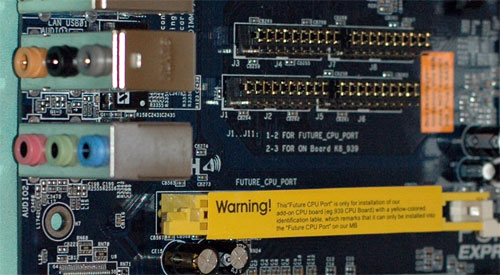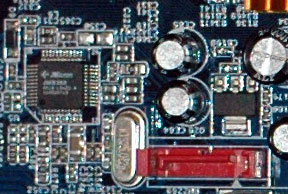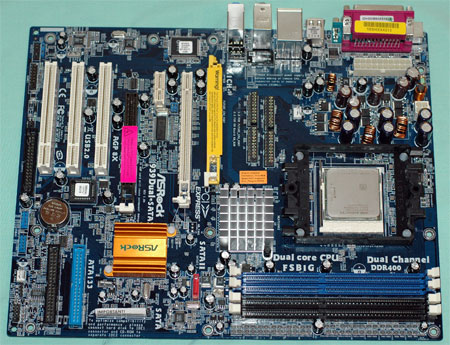ASRock 939Dual-SATA2: First Retail ULi PCIe/AGP
by Wesley Fink on September 7, 2005 12:05 AM EST- Posted in
- Motherboards
Board Layout: ASRock 939Dual-Sata2



The 20-pin (not 24-pin) ATX connector and 4-pin 12v connector are located between the CPU socket and the IO ports on this 3-phase board. This is not the most ideal location, but with both connectors near the board edge, it works well.

Value boards often present challenges in board layout to the end-user. Since the selling price is usually of foremost importance, the layout is often geared to efficient manufacturing more than end-user convenience.
The ASRock 939Dual-SATA2 is generally well laid out. Some thought clearly went into connector placement, but there are a few glaring oversights. The floppy and IDE connectors were hard to work with in a mid-tower case in light of their bottom right location. A standard IDE cable would barely make it from a top-mounted optical drive to IDE2. The floppy at the center bottom is particularly troublesome if you still use a floppy drive. If you don't, then it's a moot point.
You can clearly see the Asus heritage in the fact that ASRock uses only passive heatsinks on the 939Dual. Certainly, this is the best solution where noise is a concern, but it does not always provide for the most efficient cooling. Our experience during testing and overclocking the ASRock was that the Northbridge became pretty warm, but not warm enough to cause a shutdown or reboot.











56 Comments
View All Comments
tayhimself - Wednesday, September 7, 2005 - link
What about SATA, USB, sound, and ethernet performance. This seems like an incomplete review to me. I find these side performance issues are becoming more and more important. The RS480 for example has lousy SATA and USB performance which would rule it out for some who use those heavily.Wesley Fink - Wednesday, September 7, 2005 - link
We covered ULi SATA, USB, IDE, and other peripheral performance in our review of the 2nd ULi cReference Board at http://www.anandtech.com/mb/showdoc.aspx?i=2489">http://www.anandtech.com/mb/showdoc.aspx?i=2489. It seemed redundant to test features in the chipset again or external chips that we have just benchmarked. The ULI IDE and SATA performance were top-notch, and the USB was competetive (much better than ATI). Please refer to the ULi review for chipset benchmarks.We did not test the JMicron SATA2 3Gb performance since we have not yet standardized on a 3Gb test platform. The Holy Grail at AnandTech is that a benchmark by itself is an advertisement - it takes 2 or more benchmarks compared for a review. AnandTech has been working on a chipset performance comparison for storage, and you will soon see comparison benchmarks for SATA2 performance in addition to SATA1.
OvErHeAtInG - Wednesday, September 7, 2005 - link
AFter rereading the review of the ULi ref board rev 2, I did notice that the ULi reference board had used the Realtek ALC655, and this board (ASRock) lists the ALC850. I don't really know much about this topic, but based on the review of the reference board I would be a little bit worried about the CPU utilization of the ALC850? This is frankly critical to budget gamers I think. One doesn't want to use the on board audio if it will use 30% CPU. Can you enlighten me Wesley?Tnx
tayhimself - Wednesday, September 7, 2005 - link
Thanks for this reply and the others. Good to see the reviewers checking comments. Props!yacoub - Wednesday, September 7, 2005 - link
If this is priced equivalent and not more (and we know that won't be the case) then it might be worthwhile. If it costs $50-100 more, it would be no better than selling one's current AGP gpu and picking up a PCI-I gpu and ignoring any issues that might come from this freaky PCI-E/AGP/M2 board. :)bhtooefr - Wednesday, September 7, 2005 - link
It's $68 at Newegg.Newegg's cheapest Socket 939 PCIe (RS480 in this case) mobo is $66, and it's an ECS (ECS is on my blacklist).
The cheapest non-ECS board that has Socket 939 and PCIe is this, and the nearest board in that class (non-ECS, S939, PCIe) is $75.
Also, keep in mind, in performance, it keeps up with the big dogs. So, let's make it RS480s and NF4Us as the competition. Now, you're talking $80 for a Biostar NF4U, $84 for a Jetway RS480 (again, the ECS board is an RS480...)
So, it's DEFINITELY worth it.
BTW, this can run dual-GPU (not SLI). Wanted to run four heads, with two 3D render jobs running at once? This is the board to get. (Heck, ULi calls it "triple graphics technology", because of good ol' PCI GPUs. For that matter, there's PCIe 1x GPUs...)
Powermoloch - Wednesday, September 7, 2005 - link
This is marvelous :) !! for 68 $?? AsRock my be crazy by setting that price range. In any case, This is great for me and users who are in a similar situation, those who didn't want to blow wads of cash on another high end pci-e card for an upgrade. This is great news, kudos to everyone who made the product and a great review too from anandtech.comSynthDude2001 - Wednesday, September 7, 2005 - link
I don't know what to say other than "awesome". It's been a long time in coming, but finally there's a solution out there for all of us high-end AGP owners that don't want to ditch last year's $350 video card just yet. ASRock has also already released one new BIOS version since the board was introduced, so I'm not worried about small issues.Unless another manufacturer comes out with a board based on this chipset/southbridge within the next month or two, this will be the board I buy to finally move into the Athlon 64 world. For $65, you can't really go wrong.
Calin - Wednesday, September 7, 2005 - link
At its time, I bought a SIS735 board (with RAM support of up to PC133 and PC-3200, two memory slots for each). This looks like the new "transition" board to have :)flatblastard - Wednesday, September 7, 2005 - link
"It will likely sell very well regardless, as many will also notice the slot for a future M2 expansion board.".....A slot that likely will never be populated and even more likely not to be supported by Asrock in the future. But hey, if it helps sell a few thousand more mobo's, more power to them.